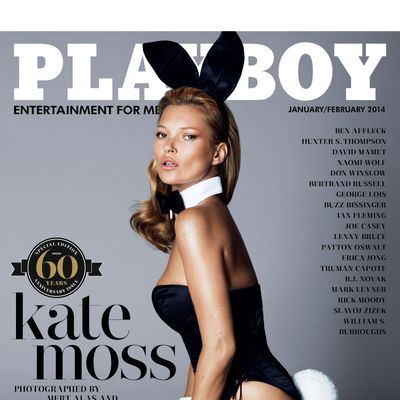
In a time when free online media poses an existential threat to print magazines and traditional pornography, 60-year-old softcore monthly Playboy is having a weirdly controversial moment. Evaluating the anniversary issue in Time, Peggy Drexler railed against the magazine’s portrayal of Kate Moss as a “man’s fantasy at the ready.” “It is no longer every man’s fantasy to dominate a woman dressed as a furry woodland creature,” she wrote. “It is no longer every woman’s fantasy to oblige.”
Despite her insistence that times have changed, there was something almost retro in her indignation. There are now websites for couples who both fantasize about dressing up as furry woodland creatures (or adult babies or cartoon characters), not to mention sites where adults can share photos surreptitiously taken of young women’s asses. Playboy, with its almost-40 celebrity cover model, her pubic hair, and a well-meaning feminist panel featuring Erica Jong and Naomi Wolf, seems kind of quaint by comparison.
This is intentional, part of Playboy’s new business strategy of not offending women so that they might become customers. Editor-in-chief Jimmy Jellinek pledged to Slate that Playboy would abandon its “aesthetic of unattainable perfection” — which he believes prompted “unhealthy competition” among women — and return to a “more healthy, naturalistic” “Darwin-given” beauty. (See: Moss’s freckles and finger waves.) Kind of him to consider the trauma wreaked on the female psyche, but this campaign seems as dated Drexler’s take. Women don’t necessarily look to Hugh Hefner as an aesthetic authority — not even when it comes to softcore sex pics. (See: the Suicide Girls phenomenon.)
Yet Playboy’s time-honored brand of benevolent sexism remains an appealing target for criticism, perhaps because it’s so old-fashioned. If only untangling contemporary sexism and sexuality were as straightforward as exposing the Playboy Club! In the New Republic, Diane Mehta charged Monday that erotic literary magazine Adult’s “kittenish” and “coquettish” photographs, though woman-edited, made women out to be “for the most part, mere objects.” “Prickett and her contemporaries may have grown up desensitized by porn and flooded with photoshopped images of beautiful women,” she scoffed, “but their feminist-erotic aesthetic is as sultrily coy as an old-school issue of Playboy.”
But it’s not the sexual politics of the sixties Playboy and Adult are nostalgic for, it’s the cultural clout of magazines. With an unlimited supply of high-resolution breasts and tans online, Adult’s portrayal of thin, white women as “gorgeous playthings,” as Mehta put it, aren’t trying to look empowered — they’re trying to look expensive, tasteful, and rare. In other words, the way pictures of women looked back when issues were still thick. No one pays for selfies, after all.




